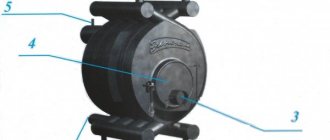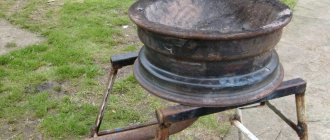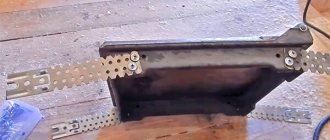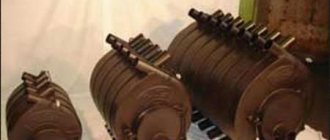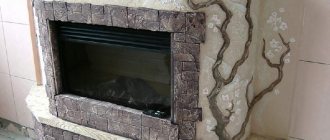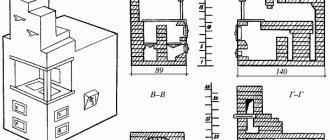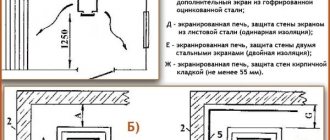Advantages of metal stoves
Iron stoves have a number of advantages. These include:
- Heat dissipation. Wood-burning stoves made of metal warm up and begin to give off heat much faster than brick products.
- Small dimensions. Installation of metal stoves is possible if there is a minimum
- a lot of free space in the room.
- Mobility. Iron products can be easily moved from one place to another if necessary.
- Simplicity. Anyone can use a metal wood-burning stove.
- Functionality. Many modern models are equipped with a hob and oven. This allows you to cook food on them.
- Saving. An iron stove can be used to heat a house without the cost of additional equipment (radiators, pipes, etc.).
The advantages of these products also include the fact that, in addition to their main functions, they give the room a respectable appearance and comfort.
Flaws
The most significant disadvantage of metal stoves is the inability of the walls of the structure to “breathe”. Unlike a metal stove, a brick stove absorbs moisture from the surrounding space, and releases it as it warms up during operation. This means that in a building with stove heating based on a stone stove, the level of relative humidity is independently maintained within the limits of optimal standards for human health. Of course, a brick-lined metal stove will be able to “breathe” slightly, however, the effect of such an exchange of moisture will be very insignificant. In addition, a stove lined with basalt brick, plasterboard or stone will lose its inherent strength, and there is no point in talking about the mobility of such a structure.
A metal stove, in comparison with its brick counterpart, has a lower heat capacity, as a result of which, after 2-3 hours after the end of combustion, its body will completely cool down. To maintain the required temperature in a heated room, a metal stove must be constantly heated. If such a stove is installed in a residential area, constant burning of fuel increases the likelihood of carbon monoxide, which is dangerous to human life and health. Moreover, during its operation, a metal furnace can become heated until the walls of the structure become red. Agree that this increases the likelihood of injury and can lead to a fire. It is for this reason that employees of the Ministry of Emergency Situations agree to certify metal stoves of their own making only for heating areas of non-residential isolated premises.
And, finally, the most important drawback of stoves made of metal. Metal stoves, in comparison with their brick counterparts, have a very short service life. The fact is that metal exhibits slightly greater chemical activity than ceramics. And when exposed to elevated temperatures, activity increases several times, which leads to corrosion of the walls of the structure. As a rule, metal stoves do not last more than 20 years. However, it should be noted here that the short service life of a metal stove is compensated by saving money on the purchase of fuel, as well as by the possibility of replacing the heating device without repair work, which cannot be avoided when replacing a stone stove.
Operating principle
Using a metal stove in a home or non-residential premises requires regular monitoring of the operation of the device. The loaded fuel is enough for a certain period of time. Therefore, it is necessary to constantly reload firewood into the firebox. Home ovens may differ in design, but the principle of operation is the same for all models.
The principle of operation of a metal stove for the home
Firewood is loaded into the combustion chamber. During the combustion process, air enters the combustion chamber through a specialized hatch (blower). The blower is equipped with a door, with the help of which the amount of supplied air is regulated. The more oxygen supplied to the combustion chamber, the faster the fuel burns. Products resulting from combustion are released into the atmosphere through a smoke duct.
Depending on the model, ovens can be additionally equipped with hobs and ovens. The flame in the combustion chamber quickly warms up the cooking surfaces. For aesthetic purposes, many manufacturers make the combustion chamber door from heat-resistant glass. So, you can see the process of burning wood while working.
How to choose a stove type and organize a heating scheme
What is a stove?
Before continuing further conversation about stoves, it is necessary to define the concept itself. So what is a stove? Despite the different definitions present in different sources of information, we will assume that a stove is a device designed to generate thermal energy and its subsequent transfer to consumers without the use of heat supply communications.
Domestic ovens
Domestic stoves are heating and cooking generators of thermal energy. The main schemes for converting fuel combustion energy into heat are shown in the figure.
Chamber furnaces
On the left in the picture you can see a chamber-type oven. Similar designs have been used by humans since ancient times. In a chamber-type furnace, the flue gases emanating from the furnace enter the gas chamber through natural circulation, where the process of their final combustion is completed. The air required for fuel combustion also enters the firebox naturally. Simply put, a chamber oven is a fire in a cave. An example of a chamber-type oven is the traditional Russian oven.
Channel furnaces
In a furnace with a channel design (middle image), the burnt flue gases, passing through the channels of the structure, give off heat to the walls of the furnace. The process of combustion of flue gases is possible only after the furnace body has warmed up to a temperature of 400°C, therefore it is impossible to achieve high efficiency values from a furnace of this type.
Bell furnace
The right image of the picture shows a bell furnace. In a device of this kind, flue gases are kept under the roof of the hood until they are completely burned. Subsequently, the cooling flue gases descend down the walls of the furnace, releasing the available heat. The bell furnace has an efficiency factor of about 70%.
Metal based furnaces
Since metal has high thermal conductivity and low heat capacity, it cannot be called an effective thermal energy storage device. Simply put, metal heats up very quickly and cools down just as quickly. However, building a competent design of a metal-based furnace will create conditions for faster heating of the firebox and combustion chamber of flue gases, which will increase the efficiency of the heating device. The figure shows schematic images of modern metal furnaces.
Chamber metal furnace
A metal chamber-type furnace is represented in the figure by position “A”. This is nothing more than the familiar potbelly stove. Metal chamber furnaces first appeared on the market at the beginning of the 19th century. In those distant times, fuel was very cheap, so no one paid any attention to the unusually high gluttony of this stove. After the revolution of 1917, there was a shortage of fuel resources in the country, which necessitated the need to make the chamber metal furnace more economical.
As a result of modifications, the furnace underwent the following changes:
- a grate with a door and a blower was built into the furnace body, which made it possible to regulate the power of the device depending on weather conditions;
- the chimney height was reduced to 2.5-3 m;
- the stove was equipped with a chimney whose diameter corresponded to the ratio: 7-9 mm/1 kW of the thermal power of the stove;
- a 1 m section of the chimney from the stove body was placed in a vertical position and covered with a layer of thermal insulation;
- Behind the vertical section, a horizontal part of the chimney, about 2.5 m long, was installed, which went out into the window vent of the room.
As a result of this modification, the efficiency of the chamber metal furnace was increased to 60%.
Channel metal furnace
Position “B” of the figure shows a channel metal furnace. As you can see, there is no flue labyrinth. Since metal has a high thermal conductivity, there is absolutely no benefit from the passage of flue gases through the labyrinth, therefore, in the design of this type of furnace, only one horizontally located elbow is left.
In comparison with a channel brick stove, its metal counterpart is characterized by the following advantages:
- High efficiency, the numerical value of which is 70-80%.
- The thermal power of the furnace in relation to the volume of the structure increased by 2-3 times.
- The stove is not critical to the parameters of the chimney and the amount of draft.
- The furnace operates in both continuous and flame combustion modes.
- The metal partition between the firebox and the afterburner, which has high thermal conductivity, almost instantly provides the temperature in the latter’s container that is necessary for the flash of unburned gases.
- The presence of separate air supply to the afterburning chamber and the firebox allows the stove to be operated with any type of solid fuel.
- The power of the generated thermal energy flow does not depend on the amount of fuel loaded, but on the air supply mode.
- Using high-quality coal or wood fuel will increase the frequency of chimney cleaning work up to 5 years.
long burning stoves
Metal furnaces with a bell-type design cannot operate in combustion mode. This is due to the fact that exposure to flame will quickly burn out the inner surface of the cap. Therefore, furnaces of this design operate exclusively in the smoldering mode of fuel material. As a result, it was possible to increase the heat transfer time of the heating device to 60-72 hours with one load of wood and up to 20-30 days with one load of coal. A schematic representation of a long-burning furnace is shown in position “B” of the figure.
The oven operates as follows. During smoldering, the loaded fuel undergoes pyrolysis (decomposition of the solid mass into flammable gaseous components). The gases obtained as a result of pyrolysis burn in the bell. At the same time, the efficiency of the furnace reaches 60%.
Any solid organic fuel can be used as fuel for long-burning furnaces. Long-burning stoves have high environmental characteristics, since as a result of their operation only carbon dioxide and water vapor are released into the atmosphere.
Oil-pyrolysis furnaces
Position “D” of the figure shows a schematic representation of the inside of the oil-pyrolysis furnace. This heater uses waste automobile oils as fuel.
The process of generating thermal energy begins with the slow burning of oil in the tank when primary air is supplied. During slow combustion, the oil evaporates, and its vapor enters the pyrolysis column, where it decomposes into lighter combustible fractions, the combustion of which releases thermal energy.
Application and fire safety measures
A metal stove can be installed in any room. It can be wooden, brick, concrete or a room made of any other material. The main condition for installing the device in a house (or other room) is the presence of a chimney. It must be performed separately from the centralized ventilation system.
Installing a metal stove in the house
If you use a product of large size and weight in your home, you will need to take care of the installation base. A heavy iron stove can damage a wooden or even concrete floor. A foundation must be made. It can be made of various materials. The best option would be to make a concrete foundation. To increase the strength of the base, before pouring concrete, it is necessary to install a frame of metal reinforcement.
Factory stove models meet fire safety requirements. You can easily obtain permission from the fire inspectorate to install such a product. There are models of metal stoves, the installation of which does not require obtaining permits from the fire inspectorate.
Attention: in order to avoid a fire, it is necessary to equip the wall near which the stove is installed with a screen made of heat-resistant material!
Advantages
Metal is as durable as ceramic, however, it is much easier to work with. In particular, products of any shape can be cast from metal; metal products can be forged, bent, cut and drilled. Once the metal product is formed, absolutely no energy costs are required to fire it.
Currently, there are dozens of metal processing technologies, so when creating a metal furnace, you can use any of them, which will improve the performance characteristics of the product without significantly increasing its final cost.
Another important indicator of metal furnaces is their high efficiency. Metal stoves have a value of this indicator ranging from 85 to 90%, while their brick counterparts have only 70%.
Note: the requirements of modern environmental standards for furnaces regulate their efficiency at a level of at least 70%.
A comparison of the specific strength of ceramics, and in particular brick, with metal in relation to a unit section of the material shows that a decrease in the thickness of a ceramic product leads to a loss of strength, and a decrease in the thickness of a metal part, on the contrary, results in an increase in this indicator. As a consequence, the ratio of the cost of a ready-to-use device to a unit of generated heat for a metal stove is 10-20 times higher than for its brick counterpart. To heat 100 m² of living space, on the modern market you can buy a new metal stove for only 250-300 dollars, while the seller will not charge more than 50 dollars for a used model.
The metal furnace is a one-piece structure, which, if necessary, can be quickly dismantled in one place, transported to a new location, and then just as quickly installed and put into operation. Shocks, impacts, tilts and other negative influences that may occur during transportation of the structure will not lead to loss of functionality of the device. At the new place of operation, there is no need to build a foundation for a metal stove, and the entire pre-launch installation comes down to installing a chimney and leading it outside the heated room. Also, if necessary, the metal stove can be easily dismantled and moved to a temporary storage location until it is needed again.
Due to the high thermal conductivity of the metal, a furnace based on it heats up very quickly and just as quickly warms up the surrounding space. It is the high thermal conductivity of the material that allows a metal furnace to have high efficiency. For comparison, in a brick-based stove, about 20% of the energy obtained as a result of fuel combustion simply goes into the atmosphere along with flue gases until the stove establishes heat exchange within itself and begins to accumulate thermal energy.
The walls of a metal-based furnace have a homogeneous structure; there is no metal inside, and there cannot be any porosity, which cannot be said about brickwork. As a result, the walls of a metal furnace cannot become damp after long breaks in operation. A metal stove does not require booster kindling. Due to the high thermal conductivity of the material, there are no internal heat flows in the body of the metal furnace, which contributes to the rapid combustion of flue gases within a relatively small space. This feature makes it possible to achieve greater efficiency, in comparison with brick analogues, when integrating water heating devices into the body of the furnace.
And another very important quality for private homeowners is the quality of a metal stove. A factory-made metal stove goes on sale with a fire safety certificate. In the case of a brick kiln, obtaining a similar certificate is associated with significant financial costs and loss of time. Currently, there are models of metal furnaces on the market, the commissioning of which does not require permission from the Ministry of Emergency Situations at all. All that is needed to connect such a furnace is the presence of a gas duct separated from the building ventilation system.
Types of stoves for home
Metal devices, depending on the duration of combustion, the type of fuel loaded and technical characteristics, are divided into several types. These include chamber products, channel products and long-burning devices.
Chamber furnace
This type of construction is made of steel or cast iron. There is a combustion chamber inside. Fuel is loaded into the chamber through a special hatch. The bottom of the firebox is made in the form of grates, through which burnt fuel spills into the ashpit. The ash is removed through a door located in the ash pan. This door also regulates the air supply to the combustion chamber.
Channel product
Channel devices are cast iron or steel stoves. The combustion chamber of such devices is equipped with special partitions. They are located horizontally and prevent the rapid escape of formed gases into the smoke channel. Thus, gases, mixing with oxygen, burn out, and the efficiency of the metal furnace increases.
Long burning stove
This type of device differs from others in that fuel loading must be carried out much less frequently. The air into the combustion chamber of such a stove is supplied not from below, but from above. Thus, gradual combustion of the upper part of the fuel occurs.
Metal for the furnace
It is easy to see that the physical and chemical characteristics of the metal used to create the furnace have a direct impact on the quality of operation and service life of the heating device. Therefore, when purchasing or making a stove yourself, you should pay the most serious attention to the quality of the metal. Let's look at the characteristics of the metals most often used to make stoves.
Aluminum and its alloys
On the pages of the World Wide Web you can often find descriptions of the process of manufacturing metal ovens based on such an unusual starting material, which is an aluminum milk can. Perhaps the volume of the container allows you to create a metal furnace from it, but we should not forget that aluminum has a low melting point compared to steel. Aluminum melts at a temperature of 660°C. To burn wood-based fuel, a temperature of at least 400°C is required. To ensure that combustion products do not contain carbon monoxide, which is dangerous to human life, the temperature in the boiler furnace should not be lower than 600°C. I think that all subsequent explanations are unnecessary.
Ordinary steel
The temperature limit of ordinary steel does not exceed 400°C. As a rule, a steel sheet with a thickness of at least 4 mm is used to make the furnace. It is possible that in a temperate climate, subject to infrequent use, a stove based on this type of steel will last for several years. However, ordinary steel is absolutely unsuitable for creating furnaces, which, due to operating conditions, must be heated daily. In this case, it will be very good if the heating device lasts at least until the end of the heating season.
Heat-resistant varieties of steel
Modern industry manufactures furnaces using heat-resistant steel with a thickness of 1.5-3 mm. Such heating devices are distinguished by their low dead weight and long service life - 20 years or more. Industrial furnaces based on heat-resistant varieties of steel have high efficiency, the numerical value of which exceeds 80%.
Factory-made stoves go on sale with a certificate from the Ministry of Emergency Situations, confirming the high fire safety of the device. Industrial-made metal stoves are easy to install; all the user needs is to install the device in the chosen location and connect the chimney to it.
Cast iron
According to its physical characteristics, cast iron differs from steel. Cast iron is fragile, its thermal conductivity is not as high as steel, but the heat capacity of cast iron is much higher than steel. A cast iron-based stove continues to heat the room after 3 hours after the fuel has finished burning.
For the manufacture of metal stoves, cast iron with a thickness of 6 to 25 mm is used. Cast iron stoves have a very decent dead weight. As a rule, cast iron stoves are used to heat small rooms. The low thermal conductivity of cast iron does not allow the use of stoves based on it in large rooms.
Cast iron cannot “breathe”, however, its chemical resistance is close to that of ceramics. Cast iron stoves, unlike their steel counterparts, are not afraid of long breaks in operation. Most often, cast iron-based stoves are used to heat the premises of greenhouses, poultry houses, rabbit hutches, etc.
Famous manufacturers
The Russian market offers a large selection of metal, cast iron and stainless steel stoves. Products from the following foreign manufacturers are in great demand:
- Trend.
- Magnum.
- Thorma.
- Alma Mons.
- Konig Feuer.
- Efel.
- Ferlux.
- Olimp.
The Harmony model from the Belgian manufacturer Efel has proven itself well. It is equipped with a hob and has enough power to heat a large house. The time interval between fuel loadings is about ten hours.
There are many models and domestic manufacturers:
Cinderella stove Termofor
- Termofor;
- Ligov;
- Teplodar;
- Eco fireplace;
- Ermak.
Domestic models come in various types, sizes and shapes. Some can be transported independently and moved from one place to another. Others are permanently installed and have a high mass. Many of the models are equipped with hobs, ovens and transparent doors made of heat-resistant glass.
Manufacturing
The process of manufacturing a metal stove consists of several stages - preparation of tools, consumables and design drawings, assembly of the firebox, heater, and water tank. The last stage is the installation of a homemade stove.
Tools and materials
For assembly you need to prepare:
- A grinder with metal discs.
- Welding machine, electrodes.
- Hammer, metal brush, file.
- Metal corners, metal sheets.
- Fittings for the grate.
- Metal pipes for chimney assembly.
- Anti-corrosion coating for metal.
- Doors for combustion chamber, ash pan.
If you have enough money, you can buy a transparent door for the firebox. It looks attractive and allows you to admire the flames when burning wood.
Welding machine (Photo: Instagram / tehnologia_svarki)
Preparation
Initially, you need to prepare your workplace and remove unnecessary items. Next, you need to transfer the dimensions of individual parts of the future structure to metal sheets, corners, and cut them with a grinder. Irregularities should be cleaned with a special disc.
Making a firebox
Firebox manufacturing process:
- Using a welding machine, weld metal sheets to form an open body.
- Divide it into three parts. The lowest part will be the ash compartment, the middle part will be the firebox, and the top part will be the closed heater.
- Weld fittings between the ash pan and the combustion chamber to form a grate.
- Weld a thick metal sheet between the firebox and heater.
- Cut a round hole in the top sheet of metal. It is needed for the chimney, which will pass through the heater and go outside.
It remains to cut holes in the front metal sheet for the ash pan and combustion chamber. External corners need to be reinforced with metal corners. Welding seams must be cleaned with a metal brush and treated with an anti-corrosion compound.
How to make a heater?
If the heater is closed, for its final production you will need to cut a window through which stones will be laid for bathing procedures.
If the heater is open, you need to weld metal sheets on top of the stove body to create fences.
Homemade stove with an open heater (Photo: Instagram / rustam_bashpechi)
Assembling a tank for heating water
A water tank is an optional element, but if there is no boiler and no possibility to connect to a hot water supply, this is the best option for supplying warm liquid. There are two types of water tanks:
- Rectangular or square. They can be hung on the chimney, installed next to the stove or on top of it.
- Round, oval, with a hole in the center. Complex structures through which the chimney passes. This way the water heats up faster, but the tank itself is difficult to assemble.
The easiest way is to make a square or rectangular tank. The container is welded from metal sheets. A hole is cut in the lower part for the tap, and in the upper part for pouring water.
Installation of the structure
Installation Features:
- For furnace equipment, you need to assemble a base made of fireclay bricks. The optimal number of rows is 2.
- Each row must be checked with a building level.
- After installing the stove, you need to assemble the chimney. For this it is better to use sandwich pipes.
In the area where the chimney is located, the ceiling must be covered with non-combustible material.
Stove chimney (Photo: Instagram / eugene.po.wood_lab)
How to choose a stove for a wooden or country house
The walls of a house made of wood have lower thermal conductivity than those made of stone or concrete. A low-power metal stove is perfect for a wooden house. For a wooden house, you can purchase a steel or cast iron product. Power calculations should be made based on the heated area.
Stove for a wooden or country house
To install on a wooden floor, you must choose a product with special legs. Installation can be carried out either in the middle of the room or against the wall. Before installation, it is necessary to equip the wall with a heat-resistant screen. The stove is connected to the chimney. The best option for a wooden house would be to use a corrugated chimney.
For country houses, you should choose products with enough power to heat the room. A compact metal stove will provide uniform heating of a small house. A good option for a country house would be to purchase a long-burning device. This will eliminate the need for frequent fuel loading. You can purchase a stove with a built-in hob and oven.
We bring to your attention a review of Teplodar dacha stoves
Oven "Pechurka"
“Pechurka” is perfect as a country stove for the kitchen. It not only heats rooms up to 50 cubic meters, but also makes it possible to cook food in cauldrons of different sizes: the lid is a cast-iron hob with a set of removable rings. The heating stove takes up very little space and can easily fit even in a small country house, and after the end of the summer season, the “Stove” can be simply transported to its storage location in a regular car. The casing is a convector that ensures rapid distribution of heat throughout the room.
Oven "TOP model"
presents several models of stoves, each of which stands out with its specific properties. The TOP-model wood heating stove is designed for heating residential premises and cooking. Its features are dynamic convection heating of air, long-term combustion mode (up to 10 hours on one load of firewood), three-turn firebox design, two-channel afterburning system, small dimensions and a self-cooling door. The “TOP model” is an economical model of a small and affordable stove.
Oven "T-100"
Another option for metal stoves for summer cottages is the T-100 stove designs: reliable, economical, and easy to operate. They can be used for heating both residential premises and industrial areas - greenhouses, warehouses, garages. The design of this oven allows it to operate in two modes (intensive and economical), and also be used for cooking. We should also take into account the efficiency of this model - one load of fuel is enough to provide 2-3 hours of continuous operation in economical combustion mode. The heating stove is available in modifications for rooms up to 100 square meters. m.
Oven "Vertical"
Metal country stoves from “Teplodar” are also represented on the modern market by the “Vertical” line, which refers to long-burning heating and cooking stoves. This stove allows you to heat rooms up to 120 cubic meters, and it is also equipped with heat sinks for heating adjacent rooms. The vertical design of the firebox allows you to save space in which the stove is installed. produces this model in two modifications - “Ceramics” and “Metallic”.
Both are equipped with a cast-iron hob, and both modifications have a long-burning mode - up to 8 hours on one load of fuel. Also, wood-burning sauna stoves of this model are equipped with translucent screen doors, which allows you to get the effect of a fireplace - and enjoy a live fire inside the stove.
Heating stove "Matrix"
“Matrix” is a beautiful modern heating stove for a summer house or country house with an interesting design for your interior.
Effectively warms up the house and then maintains heat for up to 8 hours on one load of wood. The Matrix has a high efficiency due to the complex design of the firebox. The recessed outlet of the smoke collector saves space: the chimney can be connected both upwards and backwards, without taking up additional space under the stove. Modifications of the “Matrix” are intended for rooms up to 100 and 200 cubic meters. Go to the catalog of metal stoves for summer cottages >>>
Cons of metal devices
Despite all the advantages, metal stoves for the home also have some disadvantages. These include:
- Frequent loading required. Fuel must be loaded after a certain period of time;
- High heating temperature. The walls, ceiling, and floor at the installation site must be equipped with heat-resistant screens.
One of the disadvantages of metal stoves for the home is that they consume a lot of wood for heating.
From the above it follows that metal stoves for the home are an excellent solution when it is necessary to heat residential or non-residential premises. In addition to their main function, they can be used for cooking.
What materials are used to paint the stove?
Needless to say, bare, unpainted metal looks unattractive, even when the stove is installed in a barn or garage. Moreover, painting the surface of a metal stove will protect the device from the harmful effects of corrosion. How should the body of a metal stove be painted?
The fact is that ordinary paint begins to decompose at a temperature of 140-160°C, and when exposed to higher values, it will simply fade. To paint metal-based stoves, it is necessary to use organosilicate and organosilicon enamels. These dyes are able to withstand temperatures up to 800°C without losing their basic physical and chemical characteristics. Experts advise painting the body of a metal furnace using organosilicon enamels, and the screen, if available, using organosilicates.
Selection principles
When choosing a furnace for metal, you need to consider:
- What changes in technical characteristics should occur with metal blanks.
- What type of fuel or energy carrier is available for use. For example, if it is not possible to assemble and connect an electric stove, you can make a classic forge using wood or gas.
- What materials will be processed.
- Dimensions, weight of equipment.
Industrial equipment (Photo: Instagram / kgtmakc)
Advantages and disadvantages
Positive sides:
- High efficiency.
- Strength, reliability, durability.
- Fast heating.
- Convenient control system. With their help, you can set the exact temperature regime.
- Availability of an effective cooling system.
Negative sides:
- The stoves cool down quickly.
- Equipment material burns out when exposed to high temperatures.
If the furnace equipment will be installed under a canopy outdoors or in a garage, it is important to protect metal surfaces from rust.
Manufacturers and prices
Manufacturers of metal smelting furnaces:
- "PRO-Machines";
- "ROSInduktor";
- "Inductor".
The price of a compact induction furnace for a workshop is 60,000 rubles. The cost of industrial equipment is 500,000 rubles.
Advantages of wood stoves
The main advantages are:
- The presence of a casing that has holes for air or a combustion chamber with a system of pipes that exhaust air.
- The casing absorbs all the radiation, and when it heats up, it releases heat into the room.
- You can regulate the flow of fresh air into the firebox.
- The presence of several partitions located above the combustion chamber. As a result, the gases do not exit directly into the pipe, but first give off heat and only then go into the pipe.
- A long period of operation, which is associated with the use of refractory bricks in furnaces, the use of hobs made of cast iron, steel or other metal.
- The presence of heat exchangers that heat water, but such systems are only available in a few models.
- The so-called afterburning process of pyrolysis gases that are released during combustion occurs.
- The wood in the stove produces electricity.
- Wood-burning metal stoves release smoke to the right place, which allows you to regulate the heat balance in the living room. As a result, the rooms can maintain a stable temperature for 24 hours.
Other advantages of metal stoves, the operating principle of which is based on wood, include environmental friendliness, safety, and affordability. In particular, this applies to firewood, which is considered an environmentally friendly type of fuel. And its price is lower than for coal or peat. It is worth considering that firewood supplies must be replenished and placed in a specially designated place.



